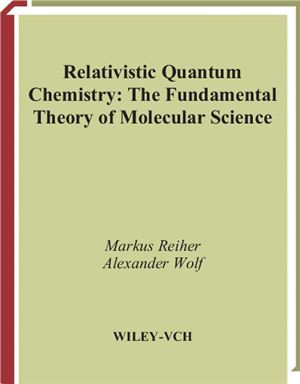Wiley-VCH. 2009. 691 p.
A relativistic consistent quantum-theoretical description of electronic bound states in atoms was first introduced in atomic physics as early as the late 1920s and has been pushed forward since that time. It was believed, however, that effects stemming from Einstein’s theory of relativity were of little or even no importance to chemistry. This changed in the 1970s when it was recognized by Pyykk?, Pitzer, Desclaux, Grant and others that several ‘unusual’ features in heavy-element chemistry and spectroscopy can only be explained in terms of so-called relativistic effects. Relativistic effects denote the deviation of results obtained in a theoretical framework which is in accordance with Einstein’s theory of special relativity from nonrelativistic Schr?dinger quantum mechanics. Since then, the development of quantum chemical methods for the description of relativistic electronic structures has made huge progress — particularly since the ate 1980s.
Contents
Preface
Introduction
Fundamentals
Elements of Classical Mechanics and Electrodynamics
Concepts of Special Relativity
Basics of Quantum Mechanics
Dirac’s Theory of the Electron
Relativistic Theory of the Electron
The Dirac Hydrogen Atom
Four-Component Many-Electron Theory
Quantum Electrodynamics
First-Quantized Dirac-Based Many-Electron Theory
Many-Electron Atoms
General Molecules and Molecular Aggregates
Two-Component Hamiltonians
Decoupling the Negative-Energy States
Douglas–Kroll–Hess Theory
Elimination Techniques
Chemistry with Relativistic Hamiltonians
Special Computational Techniques
Exteal Electromagnetic Fields and Molecular Properties
Relativistic Effects in Chemistry
Appendix
A relativistic consistent quantum-theoretical description of electronic bound states in atoms was first introduced in atomic physics as early as the late 1920s and has been pushed forward since that time. It was believed, however, that effects stemming from Einstein’s theory of relativity were of little or even no importance to chemistry. This changed in the 1970s when it was recognized by Pyykk?, Pitzer, Desclaux, Grant and others that several ‘unusual’ features in heavy-element chemistry and spectroscopy can only be explained in terms of so-called relativistic effects. Relativistic effects denote the deviation of results obtained in a theoretical framework which is in accordance with Einstein’s theory of special relativity from nonrelativistic Schr?dinger quantum mechanics. Since then, the development of quantum chemical methods for the description of relativistic electronic structures has made huge progress — particularly since the ate 1980s.
Contents
Preface
Introduction
Fundamentals
Elements of Classical Mechanics and Electrodynamics
Concepts of Special Relativity
Basics of Quantum Mechanics
Dirac’s Theory of the Electron
Relativistic Theory of the Electron
The Dirac Hydrogen Atom
Four-Component Many-Electron Theory
Quantum Electrodynamics
First-Quantized Dirac-Based Many-Electron Theory
Many-Electron Atoms
General Molecules and Molecular Aggregates
Two-Component Hamiltonians
Decoupling the Negative-Energy States
Douglas–Kroll–Hess Theory
Elimination Techniques
Chemistry with Relativistic Hamiltonians
Special Computational Techniques
Exteal Electromagnetic Fields and Molecular Properties
Relativistic Effects in Chemistry
Appendix

